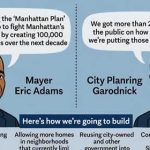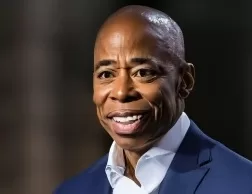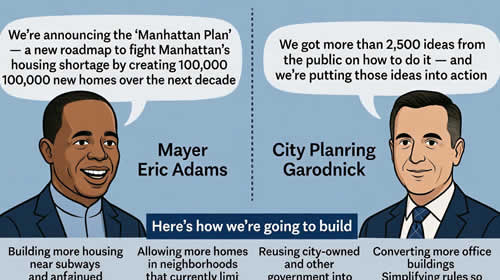Mayor Eric Adams: Good morning. Thanks all for joining. As we promised, we wanted to keep you continuously updated as we move towards this journey.
I’m joined this morning with Commissioner Ed Mermelstein and Commission Castro. Commissioner Mermelstein is from International Affairs and Commissioner Castro, as you know, is the commissioner of the Mayor’s Office of Immigrant Affairs.
And before we begin, I want to update you on the emerging weather conditions in New York City. Our team, they have been meeting and coordinating to make sure that we are prepared, as always, for any form of storm that hits the city.
We’re expecting periods of potentially heavy rain late tonight and into tomorrow. Our team is monitoring the situation, preparing, prepositioning city resources, and we’ll be briefing the media later today. First Deputy Mayor Wright and Commissioner Iscol will be leading that communication. Please stay tuned for further information.
Today, we are in Ecuador. We landed early this morning. And I really want to thank both commissioners for joining me on this trip and navigating to make sure that we can maximize our time on the ground.
And I want to thank everyone here in Ecuador for their warm welcome and hospitality and really ensuring is that we can meet as many people as possible to get a firsthand knowledge of what is taking place around the asylum seeker and migrant crisis that we are facing, and the entire Ecuadorian Ministry for their compassion and care that they are showing as we all work to manage the flow of asylum seekers and migrants throughout this region.
As I have said before, this is a fact finding trip and a trip where we want to communicate with the public in these various cities and states that we are visiting…and countries, I should say. And the genuine empathy for those who are trying to escape violence, poverty and instability is what we’re learning when we speak with them, each time we walk into a shelter or interact with men and women who are working there.
People want to help. The volunteers, employees and some of the institutions and agencies remind me of the days when the Salvation Army was helping my family, I shared with them. You see the same level of commitment and dedication from the workers who are here. These want to help people, want to help on all levels: business leaders to the elected officials all want to see how do we address this humanitarian crisis.
And I think about Sister Magda who we met in Mexico that I talked about, working with migrants every day, and people here in Ecuador like those working at the two migrant centers we visited this morning. We saw how much they care. We visited the Jesuit Refugee Center, we talked to people who are helping, and we met with individuals who have made the dangerous journey here from Colombia and Venezuela. And it’s clear that they are stretched thin and they need more support and assistance.
Now, think about the mothers who made the trip carrying babies just a few months ago and speaking with some of them. Migrants like Angie Sanchez who have been through unimaginable hardship. Her husband was injured in a guerrilla conflict in Colombia. He struggles to walk now. But Angie, like so many other migrants, is doing everything she can to provide for her family. Her story was extremely impactful and extremely emotional for all of us who heard it.
We talked with migrants about the extreme poverty they are leaving behind, and I felt their determination to seek better lives for themselves and their children. So many people we have talked to here in New York City are dedicated to solving the global asylum seeker crisis so that people like Angie can have a better future.
But in order to help, it must be honesty, and that is extremely important to us, to be honest. We must be clear about what is happening here and how it connects to what is happening in our city and in our country. We must be honest about the reality of making the dangerous journey to the United States.
We need to stop the flow of misinformation. We are hearing that over and over again from the migrants and asylum seekers, the misinformation. We are learning about Ecuadorian asylum seekers who came to America only to realize that they’ve been sold the lie they will be able to work immediately. As a result, we learned during this trip many are now asking to come back home.
We want to make sure that people come to New York City know what to expect, and they have the opportunity for a safe and dignified migration, one that can lead to the American dream; as I say over and over again, not to an American nightmare. We want every single person who is thinking about risking their lives and their children’s lives to come to New York City to know the truth about what we are dealing with.
We all want to help as many people as possible. As we have stated in this administration: our hearts are full and endless, but our resources are not. We want to uphold our values as a city of immigrants, but to do that, we need to stabilize this situation and we need work across international borders to manage it in a way that protects all of us including established New Yorkers who need services and new arrivals who need support. Right now we are in danger of not being able to provide that.
Today we saw the reality on the ground, the reality of the lives of young people and families from Honduras, Guatemala, El Salvador who have fled. We cannot just sit back and watch things play out. Ignoring the problem is not going to fix the problem. We need to take actions on issues like economic inequality, climate resiliency and the asylum seeker situation, not in the future but right now.
That is why I’m here. We need real solutions to solve these real problems, and it starts here with talking to people who are most deeply affected by it. Those solutions are going to come from all of us working together, just as the people of Ecuador and the U.S. want to do. I am hopeful that it is the start of a real international collaboration on a local level with our mayors, our governors and our national leaders.
We look forward to traveling to Colombia and the Darién Gap tomorrow to talk with more people about the reality of what has happened here and in New York City. Now I’ll take some questions on topic.
Question: Okay. So, Mr. Mayor, I’m wondering, I know that you talked about meeting with some of the migrants today and talking to them, and I wonder, when you look into their eyes and you see the desire to have the American dream and to flee the poverty, and you remember all the people in New York including your own family who came from immigrant roots, is it hard for you to tell them that they shouldn’t come to New York because it’s not…we don’t have the facilities?
I mean, does it break your heart to tell them that they can’t have the same kinds of things that people in your family and the families of the people who work in New York City have had?
Mayor Adams: What tears my heart apart and what motivated me to come here is that when I look at the circumstances that are facing the migrant and asylum seekers who are in New York and everyday struggling New Yorkers, and it is not our desire to pit the groups against each other as we stabilize this situation.
And while here, I see that same determination. All groups that attempt to come to America, they do so because they believe in the American dream. And in order for us not to have that dream turn into a nightmare, we must stabilize the situation that we are seeing.
Marcia, we used to get on the average during a challenging time approximately 300 migrants a day, we’re now seeing in areas of 600 to 800 a day. We believe that this month we’re going to see records levels because of the surge that’s taking place at the border. We are not going to be able to sustain the situation for migrants and asylum seekers and for long‑term New Yorkers who are also dealing with real issues around poverty and needs.
Question: Polo here. How far into the Darién Gap do you expect to travel tomorrow? And also, as you speak face to face with migrants, are you sharing yesterday’s announcements from DHS in Washington, the deportations for Venezuelans will be happening again back directly to their country? And then finally, just tied to that, do you expect that that fact may ultimately be what resonates with those that may ignore your message that New York is at capacity? Thank you.
Mayor Adams: Okay. I heard your first part, I just need for you to speak a little slower because of the connection here on the second part. Give me the second part so I can answer your questions together. Okay?
Question: Absolutely, mayor. Thank you. So, again, how far into the Darién Gap do you expect to travel? And as you speak face to face with some of these migrants, will you be sharing yesterday’s announcement from DHS, the deportations for Venezuelans will be happening again? And do you think that is really what will ultimately resonate with the people you speak to?
Mayor Adams: First, with the Darién Gap. We have been extremely sensitive about discussing that trip. This is an extremely dangerous trip that we are doing for a number of reasons, and we’re going to be extremely careful for intel reasons on our exact location and the time that we will be and where we’re going to be. We want to respect the law enforcement entity and those who are in charge of providing our safety.
There’s some extreme issues there that we want to respect what our officials are telling us. And so we will be able to come back, once we return, we could give a deeper briefing. But at this time, we don’t want to go into our specifics because of the sensitivity of that area.
And yes, these are the conversations, again, it’s about being honest and forthright, and we have to push back on the misinformation. And what the federal government is deciding to do, we’re going to share it with those who are here once we get a full understanding and briefing. We don’t want to add to the misinformation, and our team is vetting and getting a full briefing on what the federal government is going to do around Venezuela.
But we wanted to be clear here. We’re receiving migrant and asylum seekers from many different countries, not only Venezuela. And just as here in Ecuador and in Mexico, they’re receiving migrants and asylum seekers from many different countries as well.
Question: Hi, Mr. Mayor. I hope you’re well. So, my question is just, you know, the other day you said you were hoping to get on TV and radio and the newspapers while you were on your trip. Can you give us a bit of an idea of like what media hits you’ve done in the region thus far, if any?
Mayor Adams: The comms team will share with you the list of all the hits that we’ve done with a complete list. But we have been communicating with the local press throughout this entire trip. We met with the local press this morning and just about every stop that we’ve had we’ve had men and women from the local media that’s here, both print and television as well as radio. And we’re going to we’re going to continue to do.
We’ve been met at just about every location with men and women from the local media here in this city, Ecuador, as well as in Mexico. We were at the congressional chambers with press there, and just about every stop that we attended we had the local media there and we were very clear on our talking points of how important it is to push back on this misinformation.
Question: Thank you. Mayor, I was just wondering, did you meet with White House officials when you were in Mexico yesterday? And also, just trying to get your reaction to the border wall being built out in Texas. Do you feel like this will help maybe stem the flow a little bit? Thank you.
Mayor Adams: No, we did not meet with the White House delegation that came down a few days ago. We did meet with high‑ranking officials in Mexico, and I want to again thank them for their receptivity to sharing their ideas and we shared our dealings specifically with the wall and the proposal that’s coming from the national government.
There’s not going to be a one item solution, there’s going to be a series of things that are going to be needed to really stabilize the situation. And for Americans, the stabilization comes with managing the border. And I’m aware that many experts are stating that if you don’t have a manageable way of entry, that people take more dangerous pathways.
And so I believe the federal government is taking all that into consideration as they’re making the decision. We’re going to continue to communicate with the federal government to determine what the plans and steps forward are to not only if they officially rolled out the wall but also what we’re doing with a decompression strategy.
Question: Mr. Mayor, once the White House rolls out this plan to deport Venezuelans that are here unlawfully and also have not applied for legal protections, do you plan on assisting them with these deportations and also information sharing?
Mayor Adams: Okay, I didn’t get you completely.
Moderator: She said, do you plan on assisting the federal government with deportation.
Mayor Adams: I’m sorry, say it again?
Moderator: Do you plan on assisting the federal government with deportation efforts with Venezuelans.
Mayor Adams: What we’re going to do in New York City is we’re going to follow the law and whatever the law requires us to do in New York City [inaudible] we’re going to do that. We’re going to comply with whatever laws our city has in place. As everyone knows, I don’t break laws, I follow laws, and we’re going to make sure whatever the law is, that’s what we want to follow.
Question: So, I want to ask you about the deportations as a follow up to Bern’s question. If you’re following the law on that, does that in some way affect the city’s status as a sanctuary city? I mean, can you just kind of get into the weeds more on that? If you’re helping with deportations— which the federal government’s trying to do— would that in some way impact the city’s status as a sanctuary city? And if so, how?
Mayor Adams: Our city is very clear on what the law is around coordinating with ICE, and those are the laws that this administration is going to comply with. The laws are very clear, and I’m going to adhere to the laws that were in place prior to me getting in office, and I’m not going to do anything to go against those laws.
Question: My question is, I know you might not have had interactions with asylum seekers yet, and this is I guess your second stop. But what is the strategy once you get to wherever you will be on the Darién Gap? Are you going to directly speak to people “don’t come to New York,” do you expect them to just turn around? And secondly, I know that… I guess the question is a lot of asylum seekers who are here, New York might not have been their choice of a final destination, it’s just where they ended up.
So, I guess, what is your strategy? Are you going encourage people, turn around, while understanding that a lot of people are fleeing pretty dangerous situations and they might not— sorry— care what the Mayor of New York City and his team has to say about New York, because they want to come here anyway and take a shot.
Mayor Adams: Yes, and I think your question is a fair question of, and what we must understand, as I try to articulate as much as possible, there isn’t one item that’s going to start to slow down the pace. There’s not one item. Mayor Adams showing up at the Darién Gap is not going to change the minds of everyone that’s coming through. Mayor Adams speaking on local press is not going to change every mind.
There isn’t one magic pill that’s going to solve this crisis, and we need to be clear on that. And if we sit back and wait for the one magic pill, then we are going to watch this issue erode.
Each… I use this scenario over and over again: there are many rivers that are feeding this crisis, we have to dam each one. And I’m down here learning how to dam another river. And the federal government must do its role, the state government, the city. We all have to dam all of these rivers. If you sit back, if one sits back and state, well, if we dam one river it’s not going to stop the flow, that is a failing attitude, and I don’t have that attitude.
I’m not going to sit back and watch what’s happening in our city. And by going to Darién Gap it’s going to further educate me on the fullness of this problem by going to the source of the problems and having a clear understanding of it. Then I can come back and inform my team of my observation with the delegation that I traveled with so we can add that into what we need to do, such as, how do we better communicate at the Darién Gap?
What if we give information there before they start that journey? What’s motivating people? I’m going to speak directly to asylum seekers and migrants and learn from them at ground zero where this issue is playing out every day.
Commissioner Manuel Castro, Mayor’s Office of Immigrant Affairs: We have spoken to asylum seekers…
Mayor Adams: Go ahead.
Commissioner Castro: And just to be clear, we have been speaking with alum seekers and those who support asylum seekers and those who chose to come to Ecuador, for instance, and stay here and find a life here as opposed to going up north and through the Darién Gap, which may cost their lives.
Question: Following up on Morgan’s question just to make sure we understand your response. Are you saying that you’re concerned about the Biden administration building out more border wall or that you support the Biden Administration building more border wall as part of an overall strategy, or is it both?
Mayor Adams: And you used the right term, “overall strategy.” The White House and congressional leaders, our national leaders, they must define the overall strategy. And if the wall is factored into they’re strategy that it’s going to slow and stabilize the situation, then I respect their strategy. I have to have our strategy for the City of New York to deal with who’s here, and I have to have a strategy to assist in stabilizing the situation. That’s why I’m visiting these three countries.
And so these national policies determined by our national leaders, and if they factored in that the wall is going to assist in stabilizing the situation that we’re facing right now, then I respect their decision, because they’re making that high‑level decision. But I do know from experts that people find dangerous ways, and we need to factor that into our determinations.
New York City Hall , Manhattan, October 6, 2023
Source: NYC.gov – Midtown Tribune news –
Big New York news BigNY.com –










